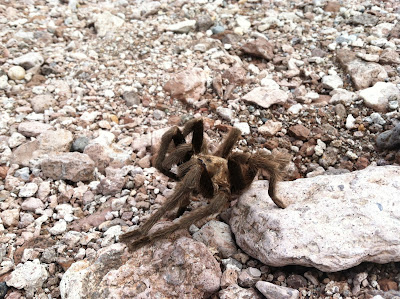My first stop was a brief one at the Bill Williams Delta, where our first winter storm of the season had brought overcast skies and drizzle. I was hoping to see the recently reported Long-tailed Duck, but it continued to elude me. I left before long without seeing much of interest. A quick stop at Parker Oasis was similarly quiet. I buzzed through the northern Parker Valley, stopping briefly to watch dancing Sandhill Cranes, check out the continuing Harlan's Hawk, and count a field full of Killdeer.
 |
| Cranes in the Parker Valley |
 |
| Flocks of hundreds of Killdeer can sometimes be seen in the Parker Valley in winter |
 |
| The Loch Ness Scoter |
My next stop on my way south was Cibola NWR. I had hoped to check a few spots, but strong winds kept me out of landbirding spots like CVCA and Nature Trail. It seemed like a good idea to just start with the Goose Loop nature drive and see what was out on the fields.
Before long, I came to a field of recently cut corn, covered in Sandhill Cranes and Canada Geese. I pulled over here and started counting: 1000 Sandhill Cranes (including one banded bird I was able to get a resight on) as well as several hundred Canada Geese. I sat in the car, scanned the flock, took photos and sound recordings.
 |
| Cranes and geese under moody skies |
 |
| Sandhill Cranes and Canada Geese at Cibola NWR |
Soon, as the sun began to sink, more flocks of geese started to join the throng. Then Mallards came in. Since I happened to be running a BirdLog checklist, I counted every flock as it came in and BirdLog added it to the totals. By the time I left an hour later, I had counted about 800 Canada Geese and 2,285 Mallards, along with 110 American Wigeon and 30 Northern Pintails mixed in with the Mallards. You can view the eBird checklist here.
 |
| It was a sea of green heads once these guys joined in |
That was all the birding I could fit in for the day, so from there I went straight to Imperial Dam and headed to Ferguson Road, which took me to the shore of Ferguson Lake. There I found the perfect campsite by the lake, where I sat with a beer under dark skies (no stars, all clouds), did a one-species eBird checklist (American Coots in the dark), and contemplated the day.
I woke well before dawn the next morning to start the CBC with a bit of owling. Although I couldn't get any Western Screech-Owls or Common Poorwills to call, I did count four countercalling Great Horned Owls. I stood over the marsh at the south end of the lake as the light started to bleed onto the eastern horizon and noted several Least Bitterns and a few Soras calling. As the sky grew lighter, more birds started chiming in: Marsh Wrens, Song Sparrows, a few Common Yellowthroats. A chupping Hermit Thrush and a few chattering Ruby-crowned Kinglets.
A hike up the nearby wash was surprisingly birdy. One of the first birds I heard was an Ash-throated Flycatcher, a very uncommon wintering bird in the area. It turned out to be a good day for them, and over the course of the day I recorded nine of these critters. Some of the other notable birds among the flocks in the wash were two Green-tailed Towhees and a Bewick's Wren.
The rest of the morning was spent scanning Ferguson Lake between intermittent bouts of drizzle. Despite fair numbers of birds like Western and Clark's Grebes, Double-crested Cormorants, and American Wigeon, I wasn't able to turn up anything unusual on the water.
 |
| Ferguson Lake in the rain |
After the afternoon lunch at Phil Swing Park with the rest of the bird counters, I spent some time wandering around desert washes, then headed toward Bard to look for rarities. During this time I realized I wasn't finding any sparrows! In areas where I've previously seen hundreds of sparrows in winter, I was seeing one or two White-crowned Sparrows at best. No Black-throated Sparrows, and only a handful of Savannah. The habitat seemed grassy enough, so I'm at a loss to explain the absence of sparrows and other grass-eating birds.
 |
| One of the highlights of my afternoon, a chilled tarantula |
As the sun started to drop, I buzzed over to Betty's Kitchen to look for the previously reported Thick-billed Kingbird, which would be a Yuma County bird. Before long I heard a call I didn't recognize, like a big squeaky Lesser Goldfinch. I tracked it down, and sure enough, it was the kingbird! It posed for photos and great looks before moving further into the cottonwoods. I walked around the restoration area, tromping through the mud while trying to pick out different species at this incredibly birdy spot. Not a bad end to a nice day of birding!
 |
| My first Yuma County Thick-billed Kingbird. Success! |

Wow Lauren! What an adventure, and a great culmination with the Thick-billed Kingbird!
ReplyDeleteWatching and hearing al those Ducks and Geese amassing must've been a pretty surreal experience (unless, of course, you experience that often) too.
Busy weekend, beautiful birds!
It's not something I experience often at all--it was my first winter visit to Cibola, and that's the major concentration of these birds around here. It was incredible!! I couldn't believe how many Mallards were continuously streaming in, and I don't think I'll ever get over the sounds of cranes. :)
Delete